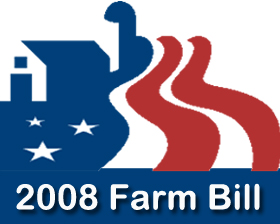
The economy of Togo has struggled greatly. The International Monetary Fund (IMF) ranks it as the tenth poorest country in the world, with development undercut by political instability, lowered commodity prices, and external debts. While industry and services play a role, the economy is dependent on subsistence agriculture, with industrialization and regional banking suffering major setbacks.

The Agricultural Adjustment Act (AAA) was a United States federal law of the New Deal era designed to boost agricultural prices by reducing surpluses. The Government bought livestock for slaughter and paid farmers subsidies not to plant on part of their land. The money for these subsidies was generated through an exclusive tax on companies which processed farm products. The Act created a new agency, the Agricultural Adjustment Administration, an agency of the U.S. Department of Agriculture, to oversee the distribution of the subsidies. The Agriculture Marketing Act, which established the Federal Farm Board in 1929, was seen as a strong precursor to this act. The AAA, along with other New Deal programs, represented the federal government's first substantial effort to address economic welfare in the United States.
An agricultural subsidy, is a government incentive paid to agribusinesses, agricultural organizations and farms to supplement their income, manage the supply of agricultural commodities, and influence the cost and supply of such commodities. Examples of such commodities include: wheat, feed grains, cotton, milk, rice, peanuts, sugar, tobacco, oilseeds such as soybeans and meat products such as beef, pork, and lamb and mutton.
Government cheese is processed cheese provided to welfare beneficiaries, Food Stamp recipients and the elderly receiving Social Security in the United States, and is still provided to food charities. The processed cheese was used in military kitchens since World War II and in schools since as early as the 1950s.

The Federal Agriculture Improvement and Reform Act of 1996, known informally as the Freedom to Farm Act, the FAIR Act, or the 1996 U.S. Farm Bill, was the omnibus 1996 farm bill that, among other provisions, revises and simplifies direct payment programs for crops and eliminates milk price supports through direct government purchases.
In different administrative and organizational forms, the Food for Peace program of the United States has provided food assistance around the world for more than 50 years. Approximately 3 billion people in 150 countries have benefited directly from U.S. food assistance. The Office of Food for Peace within the United States Agency for International Development (USAID) is the U.S. Government's largest provider of overseas food assistance. The food assistance programming is funded primarily through the Food for Peace Act. The Office of Food for Peace also receives International Disaster Assistance Funds through the Foreign Assistance Act (FAA) that can be used in emergency settings.

The Under Secretary of Agriculture for Farm and Foreign Agricultural Services was the third-ranking official in the United States Department of Agriculture prior to reorganization of several mission areas, announced on May 11, 2017. The mission area of USDA's purpose was to "help to keep America's farmers and ranchers in business as they face the uncertainties of weather and markets..." and that "...deliver[s] commodity, credit, conservation, disaster, and emergency assistance programs that help improve the stability and strength of the agricultural economy." The Under Secretary was traditionally appointed to serve as the President of the Commodity Credit Corporation.

In the United States, the farm bill is the primary agricultural and food policy tool of the federal government. The comprehensive omnibus bill is renewed every 5 years or so and deals with both agriculture and all other affairs under the purview of the United States Department of Agriculture.
The agricultural policy of the United States is composed primarily of the periodically renewed federal U.S. farm bills.

The Agriculture and Food Act of 1981 was the 4-year omnibus farm bill that continued and modified commodity programs through 1985. It set specific target prices for 4 years, eliminated rice allotments and marketing quotas, lowered dairy supports, and made other changes affecting a wide range of USDA activities. The next year this farm bill was amended to freeze the dairy price support level and mandate loan rates and acreage reserve provisions for the 1983 crops. Again in 1984, amendments were adopted to freeze target prices, authorize paid land diversion for feed grains, upland cotton, and rice, and provide a wheat payment-in-kind program for 1984.

The Agriculture Risk Protection Act of 2000 made major revisions to the United States' federal crop insurance program and provided emergency agricultural assistance. The crop insurance provisions significantly increased the program's government subsidy; improved coverage for farmers affected by multiple years of natural disasters; and authorized pilot insurance programs for livestock farmers and growers of other farm commodities that were not served by crop insurance, among many other provisions. The emergency provisions made available a total of $7.14 billion in emergency farm assistance, mostly in direct payments to growers of various commodities to compensate for low farm commodity prices.
The commodity loan rate is the price per unit at which the Commodity Credit Corporation (CCC) provides commodity loans to farmers to enable them to hold commodities for later sale, to realize marketing loan gains, or to receive loan deficiency payments (LDPs). Marketing assistance loan rates for the “loan commodities” and peanuts for crop years 2002 through 2007 are specified in the 2002 farm bill. Nonrecourse loans also are available from the Commodity Credit Corporation for refined beet and raw cane sugar.

The Food Security Act of 1985, a 5-year omnibus farm bill, allowed lower commodity price and income supports and established a dairy herd buyout program. This 1985 farm bill made changes in a variety of other USDA programs. Several enduring conservation programs were created, including sodbuster, swampbuster, and the Conservation Reserve Program.
The U.S. Sugar program is the federal commodity support program that maintains a minimum price for sugar, authorized by the 2002 farm bill to cover the 2002-2007 crops of sugar beets and sugarcane.
The Direct and Counter-cyclical Payment Program (DCP) of the USDA provides payments to eligible producers on farms enrolled for the 2002 through 2007 crop years. There are two types of DCP payments – direct payments and counter-cyclical payments. Both are computed using the base acres and payment yields established for the farm.
The 2002 farm bill replaced the longtime (65-year) support program for peanuts with a framework identical in structure to the program for the so-called covered commodities. The three components of the Peanut Price Support Program are fixed direct payments, counter-cyclical payments, and marketing assistance loans or loan deficiency payments (LDPs). The peanut poundage quota and the two-tiered pricing features of the old program were repealed. Only historic peanut producers are eligible for the Direct and Counter-cyclical Program (DCP). All current production is eligible for marketing assistance loans and LDPs. Previous owners of peanut quota were compensated through a buy-out program at a rate of 55¢/lb. ($1,100/ton) over a 5-year period.
Marketing assistance loans are nonrecourse loans made available to producers of loan commodities under the 2002 farm bill. The new law largely continued the commodity loan programs as they were under previous law. Loan rate caps are specified in the law. Marketing loan repayment provisions apply when market prices drop below the loan rates. For farmers who forgo the use of marketing assistance loans, loan deficiency payment (LDP) rules apply.
In United States agricultural policy, the term farm programs is generally meant to include the commodity programs administered by the Farm Service Agency, as well as the other USDA programs that directly benefit farmers. Some examples of the other programs include farm loans, federal crop insurance, the Noninsured Assistance Program (NAP), the Conservation Reserve Program (CRP), and conservation cost sharing, and the "food stamps" program of SNAP, which is included in each farm spending bill because it acts as a subsidy, keeping crop prices higher by increasing financial demand for food by about eighty billion dollars per year.





